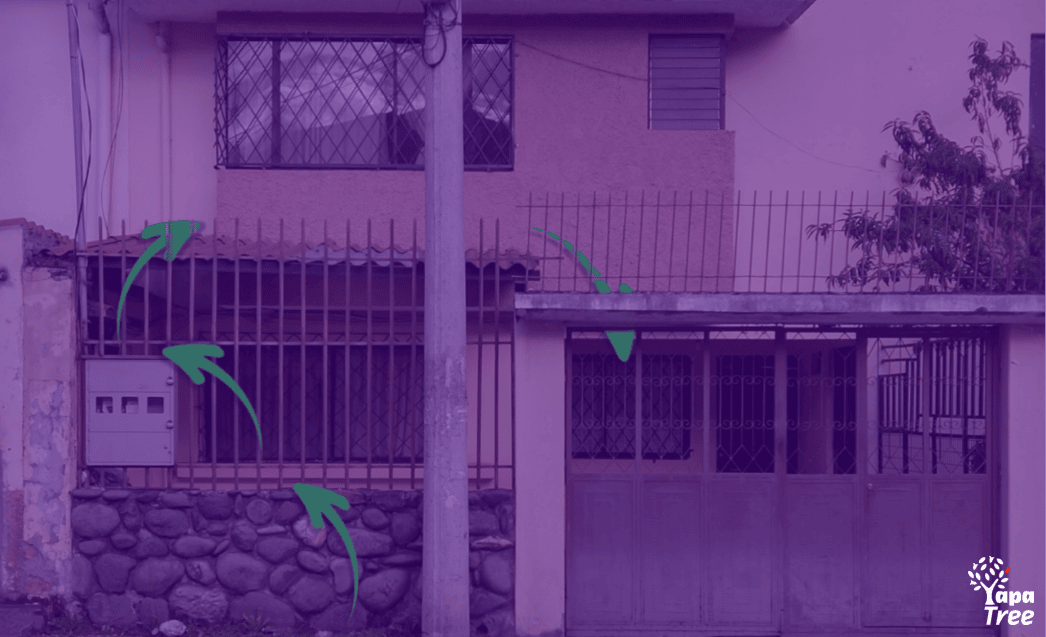Editor’s Note
This is the 2nd installment of Jeff Schinsky’s Finding a Home series. Part 1 covered Evaluating the neighborhood and we suggest starting there. Whilst this article is primarily written from the perspective of finding a property to rent, many of the same principles can be carried over when looking for a property to purchase in Cuenca. Once you’ve finished this article we suggest perusing the 3rd article in the series on lease considerations. Enjoy.
A few months after arriving in Cuenca, I found this really cool old adobe farmhouse in El Vergel, nearly 100 years old. It still had the original hand-painted Italian tile floors, a winding wooden staircase to the second floor, and many other quirky features that I found fascinating. I took one look at the place and decided I had to have it.
It had all been freshly painted, and I thought they did a particularly nice job on the kitchen cabinets. The cabinets also had all sorts of neat nooks, crannies, drawers, etc. The property also had a nice patch of green space out front, and a small enclosed courtyard in the back. So I went ahead and signed the lease and started the process of setting up the house.
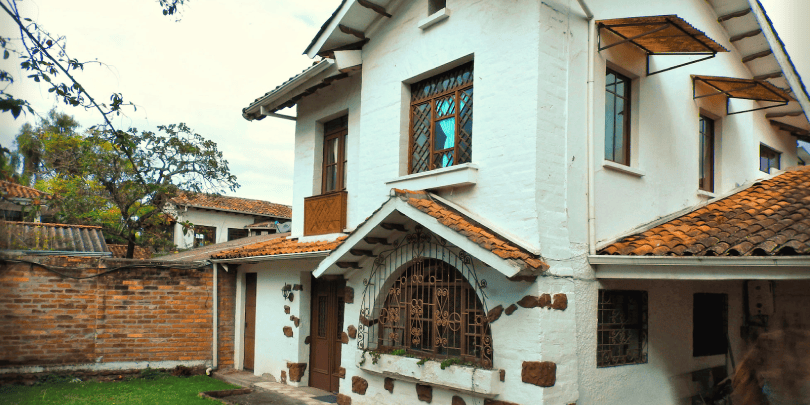
Later that day, however, I opened up the lower kitchen cabinet doors to put some cleaning supplies away… when all of a sudden a certain smell hit me. I flipped on my flashlight and looked inside, and was horrified to find thick, sticky, black mold all over the bottom sides of the cabinets and the sink. I immediately wrote the landlady and asked if I could arrange to get the problem sorted out, then deduct it from the rent. To my surprise, she opted instead to send in an architect and a crew to rip out all the old cabinets, get rid of the mold, seal the walls, and then install all new cabinetry! Of course, it wasn’t as cool looking as the old cabinets were, but I was still very relieved.
And that story, my friends, is pure aberration – things rarely work out that way here. Fortunately for me, the house had great sentimental value to the owner and his family, so they never had a problem fixing whatever needed fixing. In short, I got very lucky, and in two different ways: First, getting the owner to fix anything in a rental property here is tricky. Second, they did the job right, rather than just doing enough to make it look and smell pretty for a few months.
The point of this story is to illustrate the fact that I had no idea what I was doing when I first rented this house, and I had only a passing idea of how to properly evaluate such a place to decide if it would make a good home for me. This could have been your typical expat rental disaster, but everything ended up working out because of the owner’s personal connection to the house, and because he and his family are good and responsible people. Again, I was lucky.
Setting Expectations
In my last article, I went over the things to look for (or look out for) when choosing and evaluating a neighborhood in which to live. If you’ve not read that article yet, I highly recommend doing so before committing to any new rental property. You can find it here. For now, I’ll assume that you’ve gone through your neighborhood-eval checklist and have given the area around the home the green light.
The first thing you have to do, especially if you’re new to Ecuador, is to leave all your expectations sitting outside the door. This is not the US, it’s not Canada, and renting a home here is very different from what many of you may be used to. You’ll look at some properties here and wonder if they even had a blueprint or any other formal construction plan. It sometimes looks like they just “eyeballed” the construction site, got an idea of what they wanted to do, and then just started stacking brick upon brick. Hot and cold water faucets are often reversed, there are usually not enough electrical outlets, and those outlets are very rarely grounded. There will inevitably be defects or “undisclosed features” that you won’t even think to look for because they’re not the sorts of things that we look for back in our passport countries. So do your best to become neutral and objective, and remember that we’re essentially in a developing country. The best you can do right now is forget how perfect you feel the property is, and then do your best to spot and evaluate the most serious or bothersome issues that you’re going to find.
That’s what this article will show you how to do: Inspect a property that you’re considering renting, and, to the extent possible, identify current and future issues that could cause you considerable distress and “renter’s remorse.” I know so many people who’ve found what they believed to be the ideal home, only to end up hating it and become miserable just a few months later. As a disclaimer, I can’t possibly cover every possible situation that you’re going to encounter, but I’ll do my best to give you the most important things that I’ve learned in my nine years here. I’ll start by explaining some of the terminology that you’re going to see in the rental ads.
Terminology
- Casa: House. Keep in mind that most houses here are physically attached to the house next to it, but they are still considered individual homes.
- Departamento: This is the word most commonly used for “apartment” here. Very rarely you’ll see the alternate form, apartamento.
- Se Alquila, En Renta, En Alquiler, Arriendo Casa/Departamento: These are all some of the more common ways to say “For Rent” in Spanish. (En Venta means “for sale.”)
- Arrendador/Arrendadora: The landlord, who is usually the owner, too.
- Arrendatario/Arrendataria: The tenant.
- Amoblado: Furnished (“unfurnished” is sin amoblar). Keep in mind here that there doesn’t appear to be any standard for what is considered furnished, unfurnished, or partially furnished, so go with zero expectations and see what is included. If furnished, be sure to through the inventory with a fine-toothed comb and note any defects whatsoever: A loose leg on a table, a sagging cabinet door, the knobs and controls on all appliances, towel bars and toilet-paper holders — take photos of anything that’s not “perfect” and share those photos with the owner.
- M2: Square meters. This number, when given without qualification, usually refers to the entire square meterage of the property, and not just for the house or apartment itself. If they state “M2 de Construcción,” then that should be the number that specifies the square meterage of the home itself, and any adjacent structures. They tend to play it loose with this number, so don’t let this be a huge deciding factor, one way or the other. (They’re also very cagey about giving the precise age of the home, sometimes cutting as many as 50 years off the true number!)
- Cocina: Depending on the context, this word can mean either “kitchen” or “stove/range.”
- Encimera: Got you there, didn’t I? An encimera is a cooktop with a variable number of burners, and it’s usually fitted into an opening cut into the kitchen countertop. There may or may not be an oven included in homes with an encimera; I know one person who didn’t realize there was no oven until after they signed the lease! It’s a trick our minds play on us: We see that there’s a cooktop, and so it’s very easy to assume that there’s an oven too.
- Linea Blanca: When it’s offered with a rental property, this usually refers to the full line of traditional kitchen appliances, and sometimes includes a washer and dryer, too. Of course, the actual items making up your linea blanca can change from one property to the next, but it should still be fairly complete. You should do an “op’s check” on everything that’s checkable. If something is broken or not functioning, be sure to make a note of it in your lease and request that the owner give you a written repair-by date.
- Espacio Verde, Jardín, Patio: All used to refer to grassy areas at the property. It may only be a meter-square patch of grass, but they’ll list it.
- Terraza: Terrace. If you choose to live in an apartment, having a terrace is nice. Most people don’t use smaller terraces much, and many don’t use their larger ones as much as they thought they would. Wind is a huge issue, as is noise in some areas., But a terrace can be a nice place to enjoy some fresh air, especially if it’s covered.
Also, if you have a dog and choose an apartment, make sure you have a terrace! You can have a “poo-box” (see photo) built and filled with rock, dirt, and sod, and then have that on the terrace. This is a very convenient alternative to taking Froofy out for a walk at 3 am. You will need to water it if it’s covered, and also trim the grass as necessary.
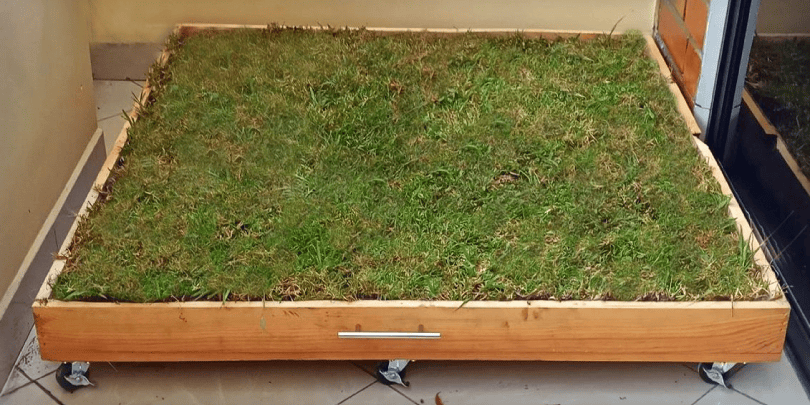
- Bodega: Here in Ecuador, a bodega is a storage space or room. One odd thing that you’ll run into from time to time is that the owner will want to maintain a storage area in the house or apartment that he’s renting to you! It’s not an ideal situation, but it’s not an unusual one either. You simply have to decide if you can live in a property where there’s a room or a shed that’s locked up with someone else’s belongings. And if you do end up with the owner’s belongings locked up on your property, be sure to put something like a 24 – 48 hour notice clause in the lease, which is the amount of notice you’ll require that the owner give you before coming over to dig through their bodega.
- Sala: Living Room (but could refer to any generic room, depending on context).
- Comedor. Either a formal dining room or a dining area within a smaller space.
- Baño: Bathroom. (A baño social is a guest bathroom.)
- Habitación or Cuarto: Both are commonly used to mean bedroom, but cuarto will sometimes be used in other contexts to refer to any room in general.
- Buhardilla: This can be an attic, a loft, or some space above the main living area(s). I’ve heard this word used mostly to describe finished or semi-finished spaces, as opposed to completely unfinished attics.
- Sótano: Basement (I’ve seen exactly one of these since I’ve lived in Cuenca!)
- Ascensor: Elevator. If you’re going to live on the third floor or higher of an apartment building, you’re probably going to want to have an elevator. But if you choose a penthouse that has an elevator that opens directly into your apartment, be aware that you’ll most likely have maintenance people coming directly into your apartment every month to do the required maintenance. Ask this question!
- Plazo: Refers to the length of the rental period specified in the lease. Be aware that you are legally entitled to a minimum two-year lease, which I personally recommend that you take advantage of (more on that in the next article on lease evaluation).
- Canon: When used in a lease, it refers to the monthly rent payment.
- Servicios Básicos: Basic services, or, in other words, your home utilities. Most often it encompasses electricity (called luz here) and water. If there’s a live landline telephone jack in the house, that will be included, too. Keep in mind that the utilities are almost always in the owner’s name, because they are the ones who are ultimately responsible if you aren’t paying the bills. Sometimes they’ll include utilities in the rent, which can be a good idea in some situations.
- Alícuota: Roughly translated, it means “your fair share.” These are building maintenance fees that are charged in almost every apartment building, and also in some gated communities. The money is used for the repairs, cleaning, and periodic maintenance of common areas. Keep in mind that many rental ads don’t even mention the alícuota, unless it’s being included in your rent. This means that if you go to look at an apartment, you need to ask the agent or owner if alícuota is included in the advertised rental amount. Keep in mind that every building charges a different amount, and this fee can also be temporarily raised for certain major projects in the building. As the tenant, you should not be responsible for paying these temporarily higher rates, so make sure to specify that in your lease. Watch for the next article on rental contracts for additional information. The best bet is to negotiate a lease where part of the amount you pay is a fixed amount that’s included with your rent payment.
- Cerco Eléctrico: Electric fence. Many homes have them here for security purposes, and they seem to be a very effective deterrent to burglars. If the home you’re looking at doesn’t have one, you can always negotiate one into your lease. Always ask if the owner will pay part or all of such a system. If they refuse, at least try to get written permission to get one installed using your own funds. For most installations, you’re probably looking at $300 – 500 for a system that will set off an alarm if touched/disturbed.
- Tranquilo: This means “quiet” when used as an adjective, especially when referring to the area around the property you’re considering. Just remember that “quiet” means a lot of different things to different people.
Now that we’ve gone over some terms you’re going to see a lot while looking at leases and housing ads, let’s get into one of the most important considerations you’ll have for choosing a home in Cuenca – security!
Security – It Always Comes First!
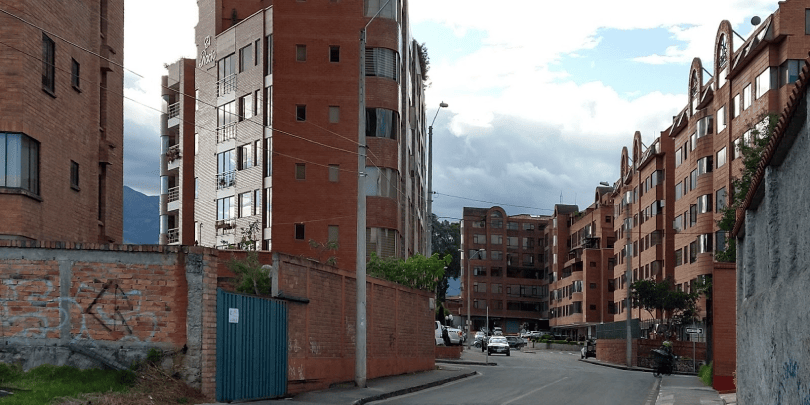
Apartments
The one thing I always hear from expats who choose to live in an apartment building (instead of a house) is that it’s “more secure,” especially if it has 24-hour security. While this may seem to be true on the surface, I personally know more people who’ve been robbed in apartments than in houses. One of those robberies was conducted by the security guard himself. In another robbery I’m aware of, the guard appears to have intentionally turned a blind eye and allowed the robbery to happen.
Think about it. Guards are just normal people like you and me. They’re subject to bribery, blackmail, and threats against them and their families. It happens. Or, in some cases, it’s just plain old “lack of character”. There are also many ways to sneak into the average apartment building, including slipping in through the garage door when it opens. Once inside, it’s just a matter of hopping in the elevator and having your run of the building.
In one expat robbery, the thieves scaled the railings around a first-floor balcony, pulling themselves up to the second floor, where the sliding balcony doors were already unlocked due to negligence on the part of the tenant. So not only did this apartment get robbed, but the bad guys then had access to the rest of the second floor.
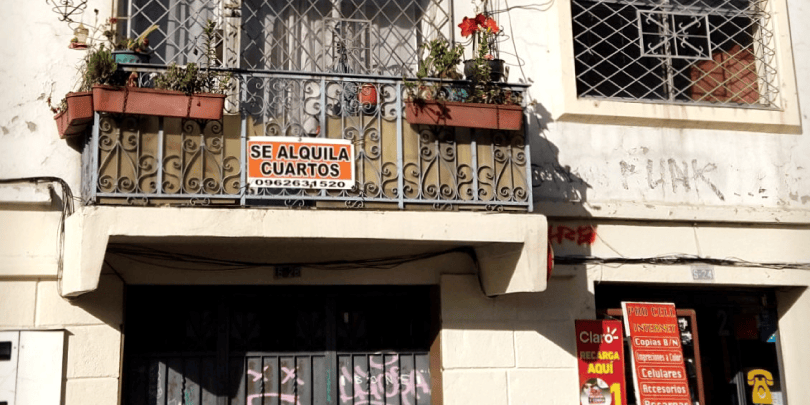
This is not an altogether unusual event, so if you take a second-floor apartment, you need to keep those doors locked! In the image shown, you can see that the second-floor terrace door and windows have additional security grates installed over the door and windows. You’ll see this over and over again throughout the historic district and elsewhere.
But you should be safe enough in a penthouse, right? Well, maybe, in most buildings. But one good friend, when moving into her penthouse, asked me to cut broomsticks to put in the bottom of the four sliding doors that led out to her enormous terrace. I asked her if she was expecting Batman to show up, and she just laughed.
But while she was on a trip to the US, burglars did go up an extra flight of stairs that led to a service area on the roof, and from there were able to drop down onto her terrace and try to break in. There were clear signs where they tried to enter through the sliding doors, but they were 100% thwarted by those broomsticks!
So then they went back onto the roof and ripped up actual roofing panels in certain places (see photo, where a black garbage bag has been placed temporarily while repairs are in progress). Then they dropped down into the space between the roof and the ceiling of her apartment and managed to kick big holes in the ceiling. For whatever reason, they abandoned their efforts just before getting inside, but they left a lot of damage in their wake. This was a case where the guard and the building administrator never bothered to lock the door to the roof access, and were thus complicit in the attempted robbery. They denied all responsibility, of course, but it was clearly a failure on their part.
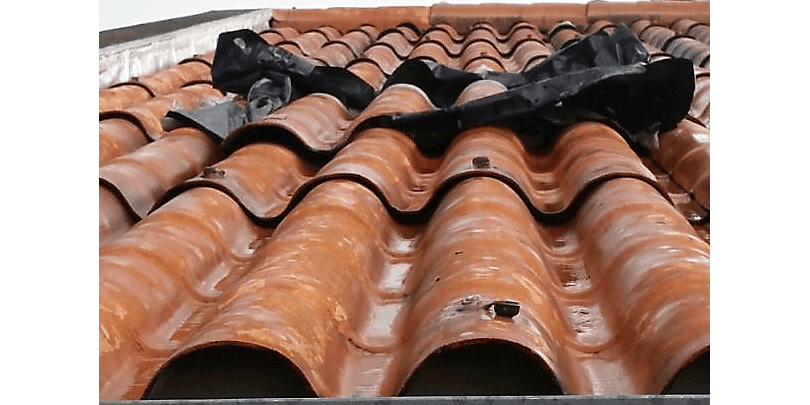
One thing worth noting is that most of the people robbed in apartment buildings are not at home at the time. They may be working, on vacation, or on an extended trip abroad. So ask yourself this: How did the bad guys know you weren’t home? Well, the security guard knows! The cleaning staff knows! The taxi driver who took you to the airport knows! Someone always knows, and most frequently they know because we told them. When going on a trip, it’s just human nature to share that with your friends and acquaintances.
So by the time you actually leave, everyone in your daily chain of events knows that you’ll be gone, and sometimes they’ll know exactly when you’re coming back. If you do trust your security guard, you should let him or her know when you’ll be gone. Or, better yet, if you have a trusted friend in the same building, give them a key for emergencies (or to water the plants, feed the cat, etc.), and then don’t tell anyone else that you’re leaving. There’s always some risk involved when you let too many people know about your travel plans, so try to limit who you tell.
Now, I don’t want to make it sound like apartment buildings are inherently insecure. There are many other apartment buildings in town that are very difficult to enter, unnoticed. They have a lot of cameras, require security fobs to enter basement doors and activate elevators, and actively educate residents on good security practices. Some have security fences around the perimeter of the property that prevents unauthorized people from getting too close to those lower-floor apartments. And in many of those buildings, the security staff has been there since the place was built, and are largely trustworthy.
So if you were to take a cross-section of all the apartment buildings in Cuenca, the quality and effectiveness of physical security varies widely, as does the character of the people working in trusted roles in that building. So if you’re considering an apartment:
- Make them show you all the security features in the building, including camera surveillance. If you see areas that appear to be poorly protected, ask them how they plan on keeping people from getting in there, how often they conduct security patrols, etc.
- In buildings where there is not a full-time security staff, take it upon yourself to make sure all security gates remain closed, and that nobody has left the front door propped open while carrying in groceries. Also, consider establishing an in-building “Neighborhood Watch” via Whatsapp to report any strange sounds or sightings to each other.
- Check to make sure that there is a lock, a passcard, or a key fob that’s required to allow people to enter the building and/or the elevator from the basement and other parts of the building.
- If you do rent an apartment, never rent out your extra parking spot to someone who does not already live in the same building and has their own means of entering and leaving the garage.
. - Don’t let people you don’t recognize enter the main lobby doors or the garage door behind you; instead, tell them they’ll need to ring the guard for entrance.
- And there’s no telling how many people still have keys to your unit. This includes the previous tenant, the owner, rental agents, the guards, cleaning people, etc. So make it a condition in your lease that you’re allowed to change out the lock, or at least get the existing lock re-keyed.
- Finally, keep those balcony doors locked when not in use, and consider putting a broomstick down in the sliding track, regardless of what floor you’re on. It may not be 100% necessary, but I bet you’ll sleep better!
Houses
There are certainly a host of security issues with houses too, but they can be every bit as secure as the average apartment building, if not more so.
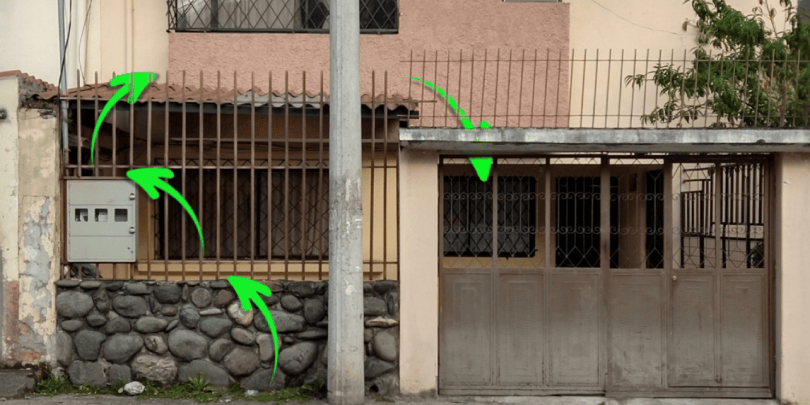
First, let’s look at a house that has serious security flaws. Notice the short stone wall at the front of the house in this photo? That’s step one. Then the box with the utility meters? That would be step number two. Then a quick hop over the fence onto the little rooftop, and then, finally, you can drop right down into the driveway.
I once watched a video of a neighbor being robbed, and they entered the property just as I described (minus the little tin roof). But many houses in Cuenca are set up exactly like this, and getting over the security wall would be a breeze for any would-be burglar.
This type of setup can be mitigated by additional metal grates installed over the windows and doors. (Not very aesthetic, but effective). It also sometimes seems like more of a hassle than it’s worth, but if you have an inadequate external security wall or fence like the one shown above, you should take the time to lock these door grates, at least in the evenings.
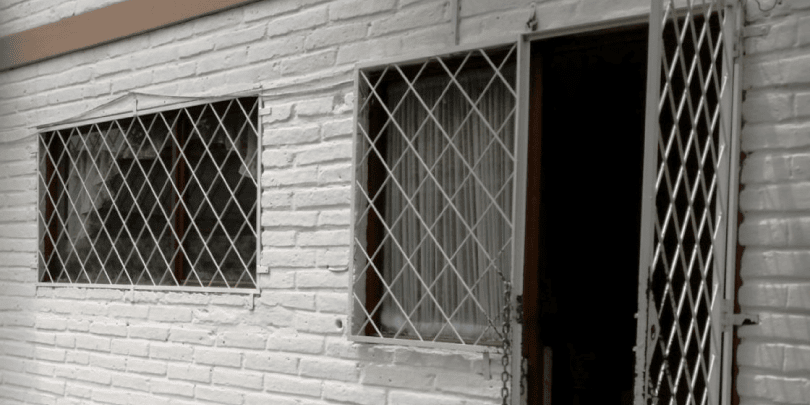
One key thing about burglary targets
In the video of my neighbor’s robbery, I also had a chance to observe the behavior of the burglar: He made his way quickly down our dead-end street, stopping and checking out each property along the way. One had impenetrable security. One house was empty. The next one had challenging security, but “Ah” – the next one was set up just like the one in the photo above. The burglar easily hoisted himself partly up the wall, stood on a fold-down garbage rack, and then effortlessly hopped over the rest of the short fence. The front door hadn’t been locked, so this guy made a good haul!
The point here is that he was picky! And what did he pick? It was the house with the weakest security on the block! There was no other target. He wasn’t looking specifically for “rich expats.” He was looking for vulnerability!
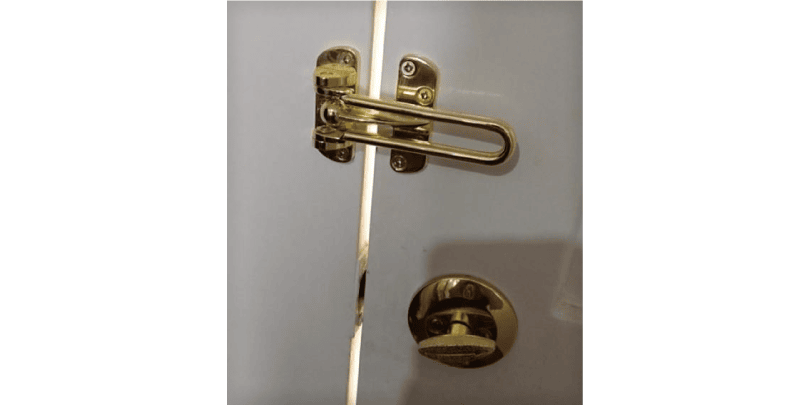
In other words, deterrence is the name of the game, and everything you can do to make your property appear less vulnerable could be the one thing that keeps you from being robbed.
So even if your electric fence around the top of your fence isn’t energized, it’s still a visual indicator to would-be burglars that this could be more trouble than it’s worth, leading him to keep on going and find an easier target.
And for additional peace of mind in the evenings, consider installing a simple flip-and-glide lock like the one in this photo.. They’re extremely simple to install and require only a flick of the finger to move it into the locked position. They are also deceptively effective at keeping out casual intruders. Someone determined to get it can always kick the door open, but there goes his goal of making a quiet and stealthy entry in the middle of the night.
An example of good security
This is one of my old houses. The basic black security gate isn’t all that tall, and could easily be scaled if the additional four feet of electrical fence weren’t installed directly above it. On the back side of the house, there were solid walls, 15 feet high.
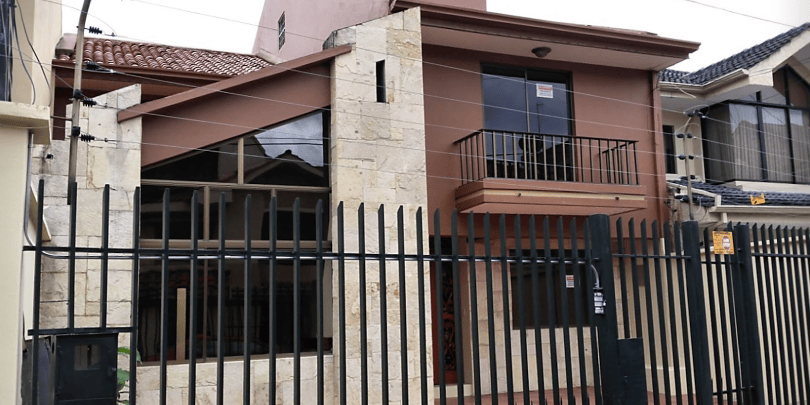
So does this mean it would be impossible to break into? Not at all! Any property can be broken into, but the burglar’s perception of what’s going to be an easy or a difficult job always figures into the equation. This is the house where I lived when I watched my neighbor getting robbed on video, and the bad guy obviously passed by my house for easier pickins. Deterrence wins again!
The time I was robbed in Cuenca
I was living in yet another house, and it had the typical security fence with open metal bars on the fence and the gate. In other words, everyone walking by could see everything I was doing outside, working on various projects I was doing with a variety of power tools.
One night, I heard a loud boom, but I thought one of the girls had dropped something heavy upstairs. The next morning, I went out to my bodega and found that the padlock hasp had been pried off, and that every one of my power tools were gone. Of course, I was really upset and went through all of the normal emotions one goes through after having been burgled. But then I stopped and looked around me, and I saw no signs of forced entry. The security gate was plenty high, so what went wrong?
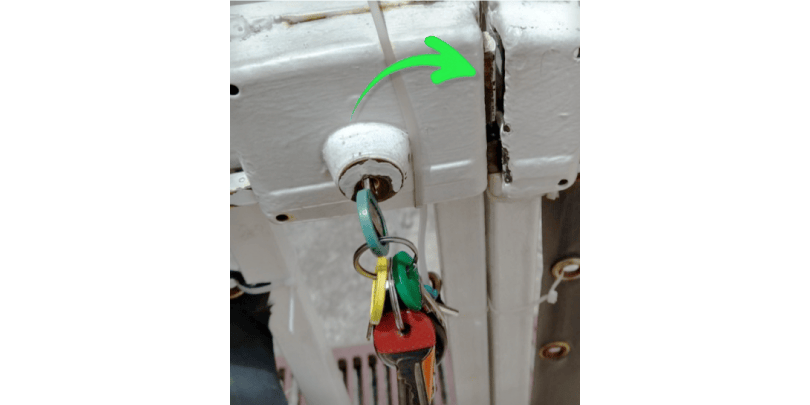
I went out to the front gate and then, after looking for a while, noticed that there was no protective metal plate covering the lock mechanism, making it extremely vulnerable. So I grabbed a screwdriver, stuck it down into the latch, and “boom!” – it popped right open! So I was essentially robbed because of a poor lock installation, and because I had personally failed to go out every night and also lock the deadbolt that was part of the mechanism.
So I know it’s a hassle, but make the trip out to your front gate every evening and lock that deadbolt! Or for locks that don’t have a deadbolt, loop some heavy chain around the moving parts and put a heavy padlock on it. Also, check the electronically activated lock to make sure that it’s well covered, and that you can’t stick some foreign object into it and pop it open.
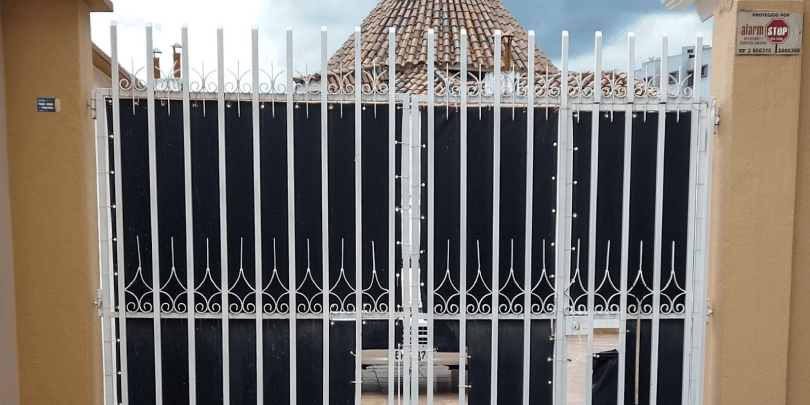
Also, my burglary was obviously targeted, since someone knew about my power tools and precisely where I kept them. But let’s assume for a moment that I was robbed simply because somebody could see through my gate and take note of everything I was doing.
What I decided to do to remedy that situation in my current home is to put this heavy, waterproof cloth over the inside of my gate. I bought a punch, a grommet die, and cut the panels to size. I then put the grommets in the fabric and secured them all to the gate with plastic zip-ties. Think of it as “visual security.” Sometimes, removing the source of temptation is all it takes, and every little thing you can do to enhance your privacy and security will add up.
Alarm Systems
Many homes have them here, but to the best of my knowledge, tenants rarely use them. They’re difficult to program, meaning you’d probably need to call the installer to figure it out. Then you have the issue of remembering to set it every time you go out. Then you have to disarm it every time you come home. In one of my homes, I had to shut the system off at night, every time I needed to go downstairs for something. So after a month of that (and sometimes forgetting to shut off the downstairs sensors), we just stopped using it. I’m not sure how things would have been different if I had paid for the alarm service, so I’ll leave that up to you to explore.
You can have alarm systems armed without being connected to a commercial security service. One such system is connected to the electric fencing, and whenever those wires are disturbed, an alarm goes off. A simple keychain fob turns it on and off, making it very convenient. If you find a house where you feel like security would be enhanced with electrical fencing, I’d recommend a system like this.
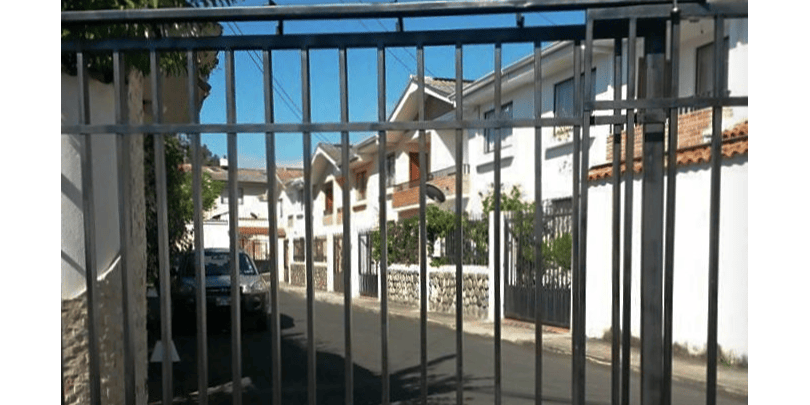
My Number One Pick for Secure Living: The Gated Community
I still hear of occasional burglaries in both apartments and houses, but one type of place where I’ve personally never heard of a robbery is in a gated community (referred to here in Cuenca as an urbanización). An urbanización has a lot of things going for it.
For one thing, some of them have a 24-hour security guard posted at the gate itself. Others have cameras to keep an eye on things, and automatically close gates to keep out unwanted vehicles.
But even the gated communities that don’t have guards are still far better policed by the residents themselves than they would be outside a gated community! Someone is always looking out a window, noting unusual sounds, and challenging any strangers who wander into their territory. Plus the residents all know each other, and in many cases, they are literally made up of extended family members. There are too many reasons for a burglar to avoid these communities, and not enough good reasons to risk getting caught inside one. To me, that’s effective security!
And now that we’ve finished covering the highlights of home security, let’s move along now and look at all the sorts of things you should be inspecting in and around the property itself.
Preparing for the Property Visit & Evaluation
I like to take five things with me when visiting a property for rent: a camera, a notepad, a measuring tape, a flashlight, and a list of measurements for those items I’ll be moving with me, so that I can make sure that all of my belongings will fit through the doors, up the stairs, around the corners, etc. You’d be surprised how many people fail to do this, and how many either end up moving again immediately, or end up selling those things they’d rather keep.
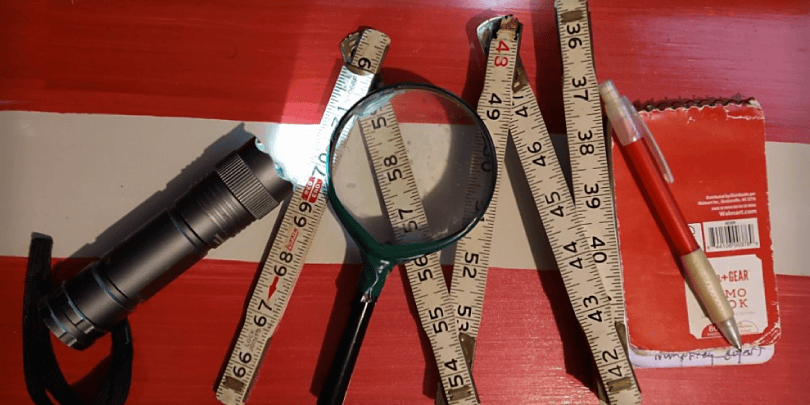
The camera is the most important item. It’s always a great idea to take your own photos and videos so you’ll remember the layout of the home later. It can get a little confusing later, trying to remember all six floorplans you saw that day! I also highly recommend doing a video walkthrough too, because photos don’t always capture the whole story.
You’ll also use the camera for documenting any and all damage or flaws that you find. Search the property high and low, taking photos of every nick, scratch, worn spot, fingerprints on the wall, cracks in the windows, stains on the floor, loose towel racks, chips out of the countertops – I mean everything that’s not 100% “perfect.” If the property is furnished, you also need to inspect every item on the inventory to make sure the descriptions and stated conditions match what the inventory says. Why go to all this trouble? Because the odds are that you will be accused of being responsible for everything that’s not “perfect” on move-out day.
One reason for this is that most leases state that the property is in “perfect condition,” which is physically impossible unless the place is brand new. So if it’s not perfect, you need to document all the reasons why it is not, and have the language of the lease changed accordingly (this will be covered in more detail in the next article).
If you decide to go ahead and rent the place, be sure to email a copy of all photos and videos to the owner, and be sure to copy yourself on all such emails. That way, on move-out day, there will be 90% less bickering over the sorts of things owners usually bicker over. Steal their thunder up-front and take some photos to protect yourself from unscrupulous owners.
Kitchens
If security is the Number One item on your list of things to evaluate, then kitchens aren’t far behind. For expat renters in Cuenca, kitchens often end up being one of the greatest sources of headaches and “renter regret.” As such, they deserve a little extra attention when evaluating them as part of your potential new home.
Mold
This is the very first thing I look for when evaluating a kitchen. As I related in my own story about mold, I got very lucky. I had no idea that mold was something that I actually had to look for here, and I had already signed a lease! So do yourself a huge favor and bend down, open the cabinet doors under the sink, and take a good long whiff. Many times there may be a musty smell, even if there is no mold, and that’s largely controllable.
Now take a flashlight and look up under the sink and the counters themselves: Are there any black splotchy growths up under there? If so, and if it’s not something that can be wiped off with a damp paper towel, it’s time to head for the door! You don’t want a house with a kitchen full of mold. Sometimes owners will try to have it “cleaned,” but there’s no cleaning black mold. Nothing short of ripping out and replacing those cabinets is going to help, and most owners will not go to that extent. You should also look in the upper cabinets, because you never know how far mold is going to spread.
Appliances (if included)
I recently watched a discussion unfold in my Facebook Group, Expats Without Agendas, where someone was looking for an oven rack. Apparently, his oven was missing one. He called around, tried different retailers, but nothing! As the discussion continued, it turned out that this was not uncommon at all! So if there’s an oven included, check for all the obvious things, but also make sure there’s an oven rack!
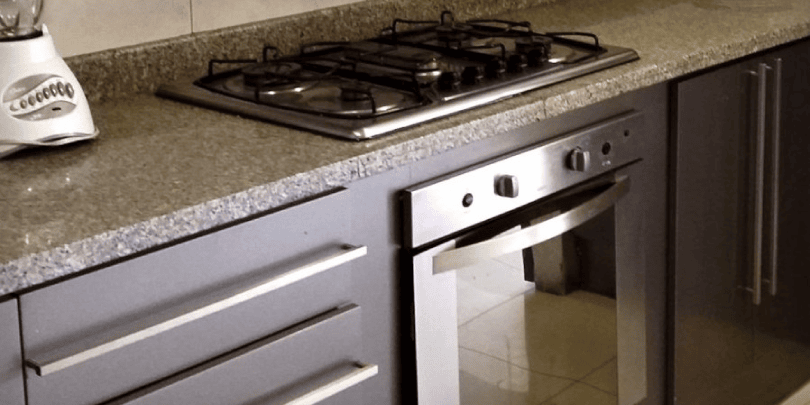
I already touched on encimeras earlier, which are simple cooktops built into the countertop. This photo shows such an encimera, and it also shows the oven installed underneath it. But be aware! – it’s very easy to take a quick look around the kitchen, see the cooktop, and let your brain convince you that there must be an oven too. This, however, is not always the case, especially in apartments.
Often, the space below where the cooktop is mounted will have another space specifically designed for an oven insert. So, if you end up needing one, that will likely be purchased at your own expense. Keep in mind that those oven inserts are almost always electric, and pretty much all of them require a 220-volt outlet. (Check for that, too!)
Then there’s my wife’s obsession – the extractor de olores, or the “range hood.” Some hoods are coated inside with grease, and you should insist that the owner have it cleaned before you move in. Some hoods work and some don’t. Some have fans that actually vent the cooking fumes outside.
Others (ductless range hoods) are not vented outside at all, and that’s okay if it is indeed a ductless range hood. Then you have some that are just big, open, passive hoods that allow the fumes to float up and out of the house without a fan or lights. So again, check to make sure the range hood functions, and that the correct type is installed if there is no outside venting.
Finally, if you have other appliances that will be included with the rental, check each and every one of them to make sure they work properly. Check all of the knobs and controls. If you don’t do your due diligence here, and something is not working when you move out, you’ll most likely take a hit on your security deposit. And while you’re checking out the appliances, you might want to look and see if you have sufficient electrical outlets for the appliances you’ll need to use regularly. If you need another outlet, an electrician can install additional ones as needed.
Cabinetry and drawers
The quality of materials, workmanship, and installation methods vary widely here. Primarily, you’ll want to make sure that all cabinets are hanging straight, that all hardware is present and functioning, that the drawers open and close easily and completely, and that there is no damage to external surfaces. Look for any scratches, chips, stains, etc., and take photos of every imperfection.
Also, look to see if there are shelves inside the cabinets! I’ve seen dozens of homes with large, roomy cabinets, but for some unknown reason, there are no shelves inside! My current house was that way, but I knew that because I had looked for it. Rather than bother the owner about it, I just ended up cutting some MDF and installing my own shelves.
Plumbing fixtures
Check to make sure that all faucets work, that the drains drain, and that the drain tubes down below the sink are tight and not leaking. If there is a problem with a faucet, then you’ll need a new faucet; replacement parts are pretty much non-existent here. The same goes for sink stoppers – most rental properties don’t have one, and finding one that will fit your specific drain is usually a fruitless task. A good idea would be to bring several types of universal drain stoppers with you when you come to Ecuador, or have someone bring an assortment down for you.
Also be aware that in many homes, the hot and cold water faucets will be plumbed backwards, e.g, “hot is the new cold!” And, it could be different everywhere in the house where there are faucets. Then there are the faucets for the washing machine, which in many cases, are both plumbed with cold water. If having hot water for your washer is important, this is something you should check for. The same may be true for certain faucets throughout the house. But, personally, I would not turn down a house over something like reversed hot-and-cold faucets.
Water pressure
Low water pressure can be a huge issue here, because the on-demand water heater (calefón) requires a certain amount of water pressure to trigger it to ignite and make hot water. You should likewise check the water pressure in the bathrooms, because it can vary from one room to the next. I’ll go into more detail when talking about the calefón itself, later in this article.
Roofs
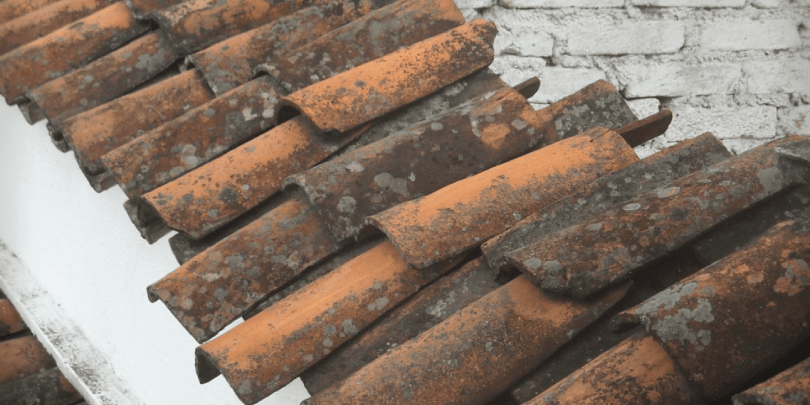
I love the look of the red-tiled roofs we have all over Cuenca, but they are notorious for leaks and can require frequent repair or maintenance. First of all, older homes use all individual tiles that sit on top of another layer of roofing material. In some homes, the tiles will start to slip off and expose the underlayment. When that happens, you’re most likely going to get a leak.
In apartments, the tiles usually come prefabricated as easy-to-manage squares, and are likewise mounted to underlayment and bolted down for security. However, as I mentioned with my friend’s penthouse, they are still not that secure, and can easily be pried up and used as an entryway into the apartment below (assuming you’re in the penthouse).
So when you’re evaluating a given home, try to see what condition the tiles are in. If you see defects, misplaced or dangling tiles, note that in the lease and give a deadline for repairs. Also, from inside the house, look up at the ceiling to see if you can find any wet spots or stains that may indicate water damage. Also look for recent repairs that have been painted over, as they may just be trying to mask an existing problem for the sole purpose of getting a new renter into the property.
Skylights
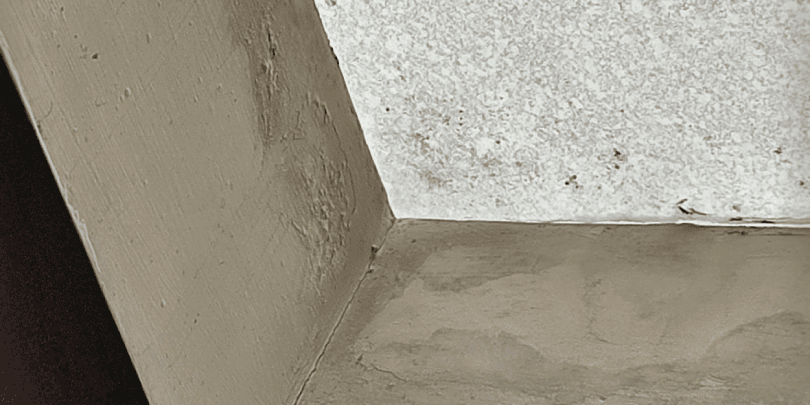
Cuenca just loves those skylights, and you’ll see them in a good number of properties here. The bad news is, a large percentage of them leak! Some leak badly.
Sometimes the leaks can be sealed, but I lived in one house where both I and the landlady had called out repair companies on multiple occasions, but nobody could fix it. I eventually had to have an architect look at the skylight in one of my houses here, and he told me that it was a flawed design, and that it was never not going to leak, no matter what they did to it. In short, it needed to be replaced, and the landlady declined to do that. Fortunately, I was aware of the leak before I moved into the house, and wrote an “easy-out” escape clause in my lease.
The Buhardilla
A buhardilla is essentially an attic space or loft, and most of the time when they’re referred to by this name, they’re at least partially finished. Otherwise, it’s only a “bodega.” Buhardillas are nice to have, either for storage or to use as an extra bedroom, office, or living space. Just keep in mind that during the warmer months, it could get uncomfortably toasty in this space.
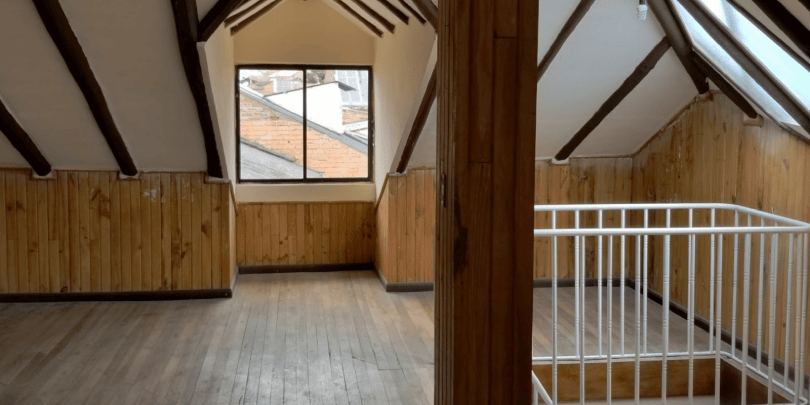
Ceilings
Most ceilings here – even in some newer construction – are a patchwork of gypsum tiles that have been hung from the underside of your roof. Some are very plain, and are spackled together so that they look like one large, flat surface. Others are more decorated and textured, which you may or may not like.
You should examine every ceiling in every room in the property, looking for any signs of leaks, water damage, or recently repaired damage. Many times the “repairs” are simply cosmetic patches that last long enough to get someone new into the property. If you see anything suspicious, make sure to put an escape clause in your lease.
Regarding “escape clauses,” they simply state that if any necessary repairs or maintenance are not handled in a timely manner, then you have the right to move out without penalty and receive your full deposit back. Or, you could also put a clause in your lease that allows you to make urgent repairs yourself, and later deduct the cost from your rent. (Please read the next article on leasing issues for more information on this process.)
Is it your ceiling, or your upstairs neighbors’ floor?
The quality of construction and materials used in apartments and duplexes vary greatly. Some have virtually no noise-transfer, while others allow you to hear almost everything that’s going on in the unit directly above you. Here’s what you should do: Ask everyone who’s currently in the property to please stop talking or making any other sort of noise. Then stop and listen for a full minute. What do you hear? Can you hear footsteps, dog-nails, or a child’s scooter? Anything? If so, I’d personally keep looking, as there are plenty of buildings with minimal noise-transfer.
Lights
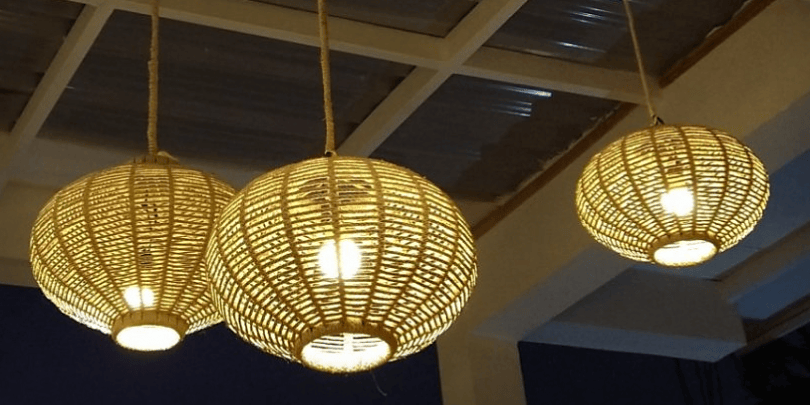
If you walk into a house and find electrical wires just dangling from the ceiling, that’s where the lights used to hang! Please note that this is a relatively common thing here, for individual tenants to install their own fixtures, and then take them with them when they move out. You can always ask your landlord to install something on those wires, but I wouldn’t expect much in the way of a positive response. Still, you never know until you try!
Now, for all the other light fixtures in the property, go through every room, turn on every switch, and make sure every single lightbulb works. Why? Because you’ll be expected to leave working lightbulbs in all those sockets when you move out, and not doing so will cause a hit to your security deposit.
Note that the ceiling tiles will not hold a screw, so if you hang a heavier light fixture, be sure to use the type of bolts that expand and grab the inside of the ceiling tile as you tighten them. If you’re only attaching a new fixture to a dangling electrical cord, then you’ll probably want to choose something that’s not too heavy.
Walls
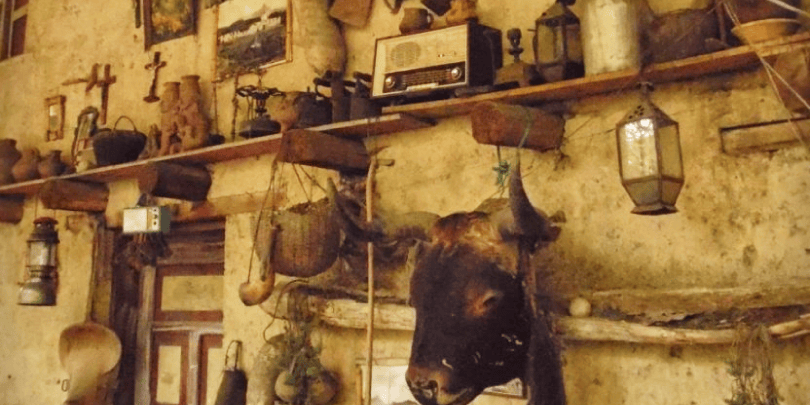
How many times in your pre-expat life did you do a thorough inspection of the walls before moving into a house or apartment? Never? (Me either.) In Ecuador, you need to get into the habit of checking them over very thoroughly. Certain problems could ruin your entire experience in a house, especially if you find some of the problems discussed below.
Where did all the right angles go?
There’s some sort of a “trend” here in some newer construction, where finding any sort of right angle between intersecting walls is nearly impossible. All the walls bend or warp or curve around, effectively eliminating all 90-degree angles. Imagine now that you have a refrigerator that’s 36 inches wide. Then, in the kitchen, you locate the space designated for the fridge, and it’s 38 inches wide at the opening. Great! That’ll work, right? Well, it should, as long as you also measure the back-end of that same space as well!
I had one friend who moved into a new place after taking all the necessary measurements, and as the movers were trying to put the fridge in place, they realized that the kitchen wall curved inwardly in that corner. This meant that the back of the space where the fridge was supposed to go was about 4 inches narrower than the front opening! She ended up living there with a fridge that was half-in and half-out of the space.
Chances are, if the place you’re looking at is short on right angles, the same will probably be true of the bedroom and living room walls as well, and you may find it a real challenge to put your furniture where you’d like to.
Paint
Look the walls over really well. If there are any stains, chips, fingerprints, or any other marks on the wall, take photos of them, or you’ll almost certainly be held responsible for them on move-out day. Fortunately, most owners will paint the inside walls in-between tenants. (Patching holes and removing old nails and screws is another matter entirely.)
Most owners these days pay the few extra dollars to put washable paint on the walls. But you’ll still occasionally find non-washable paint in some properties. You can tell the difference by lightly running your fingers over the paint; if you end up with paint-colored dust on your fingers, it’s the non-washable type. I would recommend mentioning this in the lease, and including a provision whereby you will not be held responsible for any paint issues upon moving out, because these walls are nearly impossible to keep clean. In fact, unless the property were otherwise very special, I’d probably pass on any property painted with non-washable paint.
Evaluating for noise-transfer
Just as with the ceilings, the quality of construction and the degree of noise-transfer between walls can vary greatly from one property to the next. House walls here are generally very solid, and there’s almost no noise transfer from one attached house to the other. Where you’ll find the greatest differences is in apartments, where the quality of construction can vary greatly..
There also appears to be no “standard” when it comes to local construction. Slightly older buildings seem to be a bit more solid and soundproof, but that’s no guarantee. Those “older” places are, in many cases, built of cinder blocks, concrete slab, or similar materials. (That’s why you’ll need a hammer-drill to hang anything heavy on the walls.) These types of building materials can cut most or all noise-transfer between adjoining apartments.
Some newer apartments have substantially “flimsier” walls, where you can hear almost everything going on in the adjoining units. So don’t be shy! Tell everyone to be quiet, and then put your own ear on the walls next to adjacent units and see what you can hear. In one unit I looked at, I had a friend go into the empty apartment and make a little noise for me. So he went next door and knocked on the wall and spoke a bit, and it sounded like he was almost in the same room! It’s a good thing we did that, because I was on the verge of signing the lease!
Also, keep in mind that many people work during the day and these units are often empty then. In order to get a much better idea regarding noise-transfer, ask the owner or your rental agent to arrange for you to come back in the evening, ideally between about 7 PM and 9 PM, so you can listen again. You’ll be glad you did this!
Adobe construction
The photo of the house at the beginning of this article is an example of adobe construction, as is the window below. Notice how thick the wall is around the window?
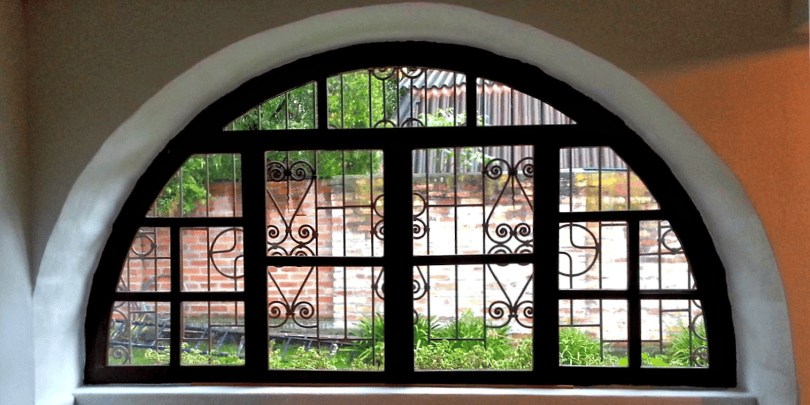
Adobe is essentially a mix of mud and straw and other random materials (bones, even!). These walls need to be thicker to support the overall load on them. They also tend to be a bit soft and can be easily damaged, so definitely use a drill to make holes in the walls.
Note that when you walk into an adobe home, it may feel cooler inside than it does outside. That’s because the adobe tends to hold in the ambient temperature. This can be slightly annoying on colder days, but this is easily remedied by running a good space heater for a while. The adobe will soak up all that heat and hold it in for much longer than other types of construction.
Adobe walls typically have bumpier and slightly uneven surfaces, but that’s completely normal.
In terms of doing an inspection, look for any larger cracks or holes and ask that they be fixed. If you see any water damage, insist that that be addressed immediately, because a wet adobe wall is a potentially dangerous wall.
Electrical outlets and light switches
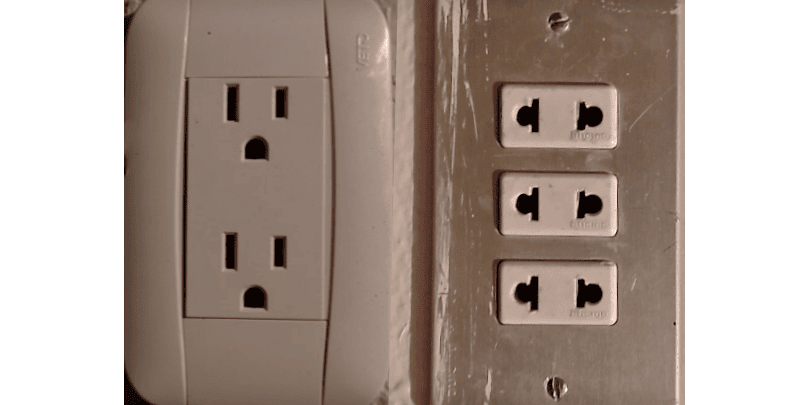
Most of the outlets you’ll see here are at least similar to the ones shown in the photo. The one on the right is a much older style, designed to take either round or flat-pronged plugs. And while they typically function fine, sometimes you’ll have polarity issues that can make certain appliances unsafe, and they can potentially damage delicate electronics.
And the outlet on the left is more modern and will accommodate a three-pronged plug – but just don’t expect it to be grounded! Even though the outlet has a hole for the ground, it will rarely be connected to any sort of ground wire. You can, however, get permission from the owner and pay an electrician to come and ground the house and the outlets for you. Likewise, you can work with the owner and the local electric company to come and install a 220-volt outlet if you need it for one of your appliances. Keep in mind that 220 volt plugs come in different configurations, so don’t get an outlet installed until you know precisely what you’re going to be plugging into it.
As part of your inspection, check every electrical outlet in the unit, along with every light switch, every dimmer, etc. Take along a small electric nightlight or a blow-dryer that will allow you to easily test the outlets. Chances are, you’ll find at least a few that don’t work. Most of the light switches and outlets here are very poorly made and fail easily. Again, any problems that you fail to find and note for the owner means that they become your problem on move-out day.
Checking walls for water damage
This is a huge issue, mainly because there are typically no drainage trenches dug between houses built in hilly areas, nor do they include a vapor barrier beneath any of the houses here.
Houses on level ground will sometimes see bulging and chipping plaster from moisture wicking up around the baseboards, and, if you’re lucky, that’s as bad as it gets. However, houses built on slopes are another matter entirely. You’ll get the same bulging and cracking and chipping, but you’ll also likely find the walls are soft and damp. During heavy periods of rain, you may also end up with water oozing through the wall and potentially spreading out across the floors, soaking everything in its path.
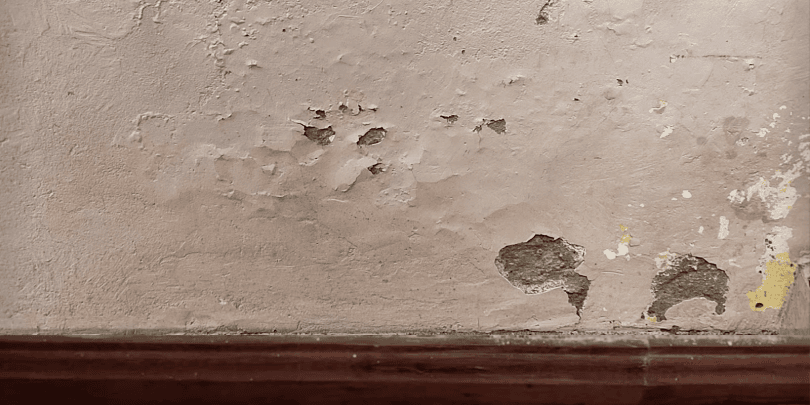
The parts of town where I’ve seen this the most are in the hilly areas up above the north side of Las Americas, and in the northwest hills above Ordoñez Lasso. If you’re looking at homes in those hilly areas, look very closely for any early signs of this sort of water damage. Also, look for signs of recent repairs and paint along the baseboards, as that’s likely only a temporary cosmetic repair.
Unfortunately, there’s very little that the owners can (or will) do about this, besides occasionally patching and repairing the damaged parts of the walls. I would personally recommend against renting in these hilly areas, or at least find some way to verify that the owner has put in a French drain, or has taken some other measures to divert the water that’s flowing directly downhill, and possibly into your own living room.
Note that sometimes there will be some slight bulging and rougher texture on parts of the wall that are not necessarily associated with water damage. Many houses have updated their electric wiring or plumbing, and since the walls are essentially solid, trenches are sometimes dug into the walls to embed those wires and pipes so that they’re out of sight.
Doors & Windows
Doors and windows in older homes and apartments are often ill-fitting, and many times you can actually see a good quarter-inch or more of daylight all around their perimeters. This is almost always easily fixed with a caulk gun and a tube of silicon, so that alone is not a huge concern. You will also likely have significant gaps at the bottom of the entry doors, so it’s highly recommended that you install door-sweeps to prevent unwelcome guests from skittering in.
The main concern for both doors and windows is that they close and lock properly. If a lock is broken on a window (or just doesn’t work), make fixing that a condition of moving in. If the repair date is set for after your move-in date, be sure to add an escape clause that gives you the right to move out without penalty if it doesn’t happen by the promised date.
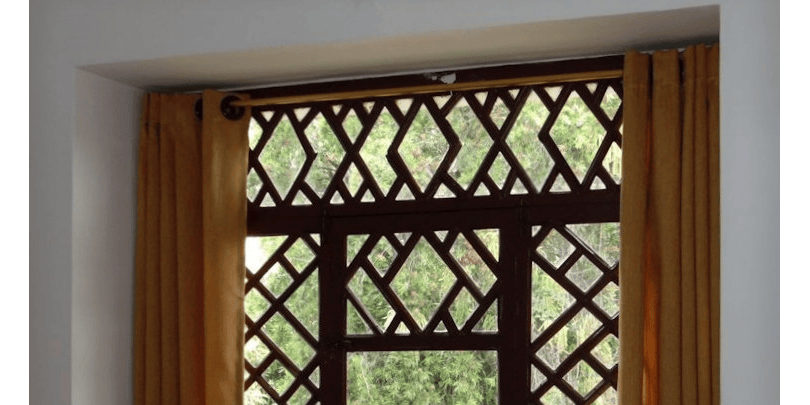
Quality of Materials and Noise Transfer
The old window in this photo, apart from changes due to age, fits perfectly, and the bottom part unlatches and unfolds to be completely open. Also, each little segment of glass was cut and fitted individually into these wooden frames. But that was 100 years ago, and they sure don’t make them like they used to! The average windows and doors in more modern construction are generally not very attractive, nor are they very effective in blocking noise.
On the front-entrance door, check to make sure it’s a solid-core door, and not a hollow-core model. designed more for bedrooms and bathrooms. I’ve not seen this frequently, but I have seen it. Once a solid door has all gaps around the frame sealed and has a door-sweep installed, it should do a fairly good job of blocking noise. But a hollow-core door? – no help with the noise, and it’s a grave security issue.
On the other hand, windows are most generally single-paned and do a very poor job of blocking noise. So you could have great doors, nice thick walls, and great noise-separation between floors and ceilings, but the noise from outside the windows will come screaming in through. The easiest way to deal with this is to choose your neighborhood wisely, as was discussed in detail in the previous article on Neighborhood Evaluation.
Newer apartment buildings and some newer homes have much better-quality windows installed, and are very good at blocking noise. As recommended earlier, you should ask everyone to be quiet while you listen to see whatever you can hear when the property is otherwise empty. When you’re inspecting the windows (and do inspect all of them!), be sure to look for any signs of leakage or gaps around the frames where water can come in.
Sliding-Glass Doors
From my personal experience, roughly a quarter of all sliding glass doors in Cuenca are very poorly installed, where the moving parts are not aligned properly, and many of them refuse to close all the way and are unable to be locked. This can be a huge security issue, plus an annoying source of outside noise. Carefully examine all sliding doors to make sure they don’t have these problems.
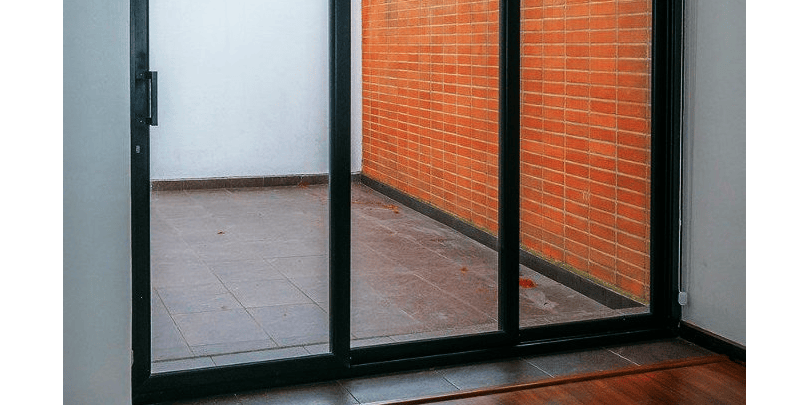
And did you notice the tiled area outside this sliding door? You really need to check that area to make sure a water drain is located in a place that will actually draw the water away from the sliding door, and to make sure that it actually drains properly. If not, you might soon find that water flowing in underneath the door frame during a downpour.
And while you’re at it, look carefully around the door frame and the flooring inside the home for signs of water damage. Sometimes you get water damage because someone left the door open during a downpour, so some damage will not necessarily mean that there’s a construction or installation problem.
In general, they do an awful job of grading and providing adequate drainage for outdoor surfaces here (including rain gutters). This is something you really need to check out, even if it means bringing a bucket or a hose and making sure outside drains function properly and keep the water out of your home. Oh – and for added security – don’t forget to cut a dowel-rod or a broomstick to put in the sliding track(s). It’s cheap, easy, and can significantly improve your overall home security.
Closets
Most closets here are built-in units, and they’re not always in the most convenient location for arranging your bedroom furniture. (This is where your furniture measurements will come in handy.) Also note that many times you’ll find doors or drawers that don’t fit or close well, or that have missing or loose hardware. You should ask to have all of that corrected before you move in.
Floors!
One thing that most prospective renters tend to gloss over is flooring. But the types of flooring in your house are going to make a huge difference in the relative warmth and feel of the house, the amount of sound that’s reflected throughout the house, and the amount of effort each type of flooring is going to require.
Wood
Some slightly older homes still have solid-wood flooring. I personally find this the most comfortable type of flooring to have, in terms of sound and warmth. Depending on how old the floor is, they can sometimes present a challenge for cleaning, but it’s something the average expat should be able to deal with.
Parquet floors
This other type of wooden flooring is the type that I have in my current house, and is shown in this photo. And although I don’t hate it, I don’t necessarily recommend it either. Parquet floors are small pieces of wood, fitted together to form some pattern. In older homes, it’s not unusual for these little tiles to pop up and need to be re-glued. If multiple pieces come up, you’ll need to take some time to make sure you have the pattern correct before you glue them back down again.
Also, cleaning these floors can be a real chore. Because of all the cracks between the tiles, using any significant amount of liquid to clean them will ultimately result in tiles being damaged and coming unglued. The typical way to clean these is to skate around your floor on a couple of big wads of soft steel wool until the dirt is gone, and then apply wax (for wooden floors) and buff them out. You don’t always have to clean them to this degree, but you can plan on doing it at least four to five times per year. When inspecting, look for any loose, missing, or damaged tiles, and then request that repairs be done before you move in.
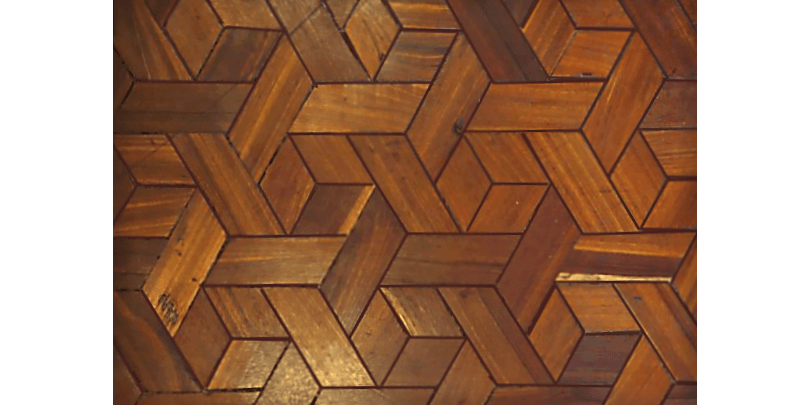
Piso Flotante (floating floor)
If I can’t have solid wood floors, this is probably my second choice for overall appearance, comfort, and acoustics. It’s a simple vinyl flooring material that “floats” on top of a thin layer of spongy material. It’s easy to clean, it absorbs far more stray noise than ceramic, and it’s generally attractive. On the negative side, piso flotante doesn’t last nearly as long as some other types of flooring. With these types of floors, you’ll want to protect high-traffic areas with area rugs or other floor coverings. When inspecting, look for (and photograph) any areas of noticeable wear or damage.
Tile/Ceramic
It’s nice and shiny, and it’s very easy to clean. But these are my least favorite types of floors because they tend to hold in the cold. Also, acoustically speaking, they absorb nothing! Noise is going to be noisier, and it’s going to bounce off the walls and into the adjacent rooms, up the stairs, etc.
In some of the much older homes, you’ll often find old hand-painted tiles, but this type of tile is generally much warmer and quieter than the modern, shiny ceramic tiles; I do like these floors!
Bathrooms
Almost everything I wrote about kitchens will apply here, too: checking for mold, checking all plumbing fixtures, towel racks, shower heads, etc. Also, flush all toilets to make sure they work, and run the showers to make sure you have reasonable water pressure. Also, make sure the shower drains actually drain.
What’s that smell?
If you smell something akin to raw sewage in a bathroom here, that’s probably exactly what you’re smelling. Vented plumbing doesn’t really happen here, so the result is that awful smell that’s present in some bathrooms here. Usually, the odor will come from a floor drain, or sometimes from the drain in the shower/tub.
“Flushing twice” helped a lot in one of my homes. In yet another, I would pour a little bit of bleach down the drain every week or two. In yet another home I cut some duct tape to size and simply covered the drain. (Fortunately, it didn’t impact the way the plumbing functioned.)
Oh, wow, a Jacuzzi!
Don’t get too excited! I’ve had Jacuzzi tubs in two of my homes, and they took so long to fill that the water was tepid by the time the tub was sufficiently full.
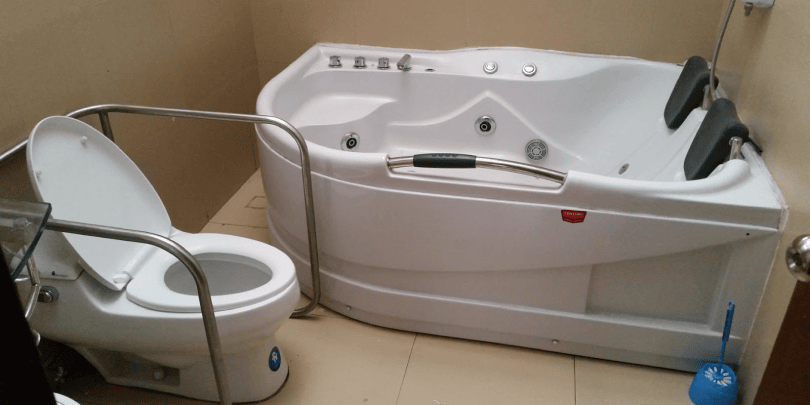
Some of the smaller tubs might be worthwhile, but definitely do not make a rental decision based on whether or not it has a Jacuzzi tub.
Also keep in mind that, generally speaking, there are very few regular bathtubs in Cuenca homes. If you find one of those that’s a good size for one person, that might be worth considering in your decision to rent or not.
Miscellaneous Things to Look for in Rental Properties
The Calefón
This is an on-demand hot-water heater, and most of them run on gas. (Some homes have electric calefóns, but I don’t have a lot of experience with those.)
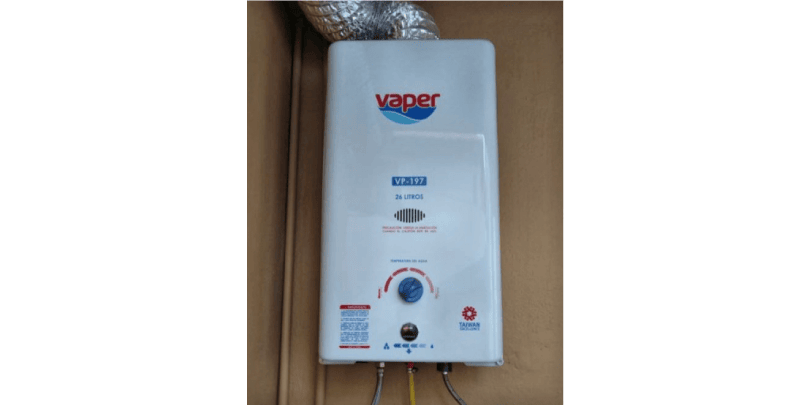
The first thing you’ll want to do is make sure the calefón is being triggered to ignite by turning on a hot-water faucet. If the calefón is functional, you’ll hear the igniter start “clicking” when you turn the hot water on. They don’t have to be connected to gas, because all it needs to try to ignite is a good D-cell battery and sufficient water pressure.
If it doesn’t click when you turn on a hot water faucet, check to make sure the hot-water supply line valve is open. Then, if it still doesn’t click, check the battery to make sure it’s good. Just in case the battery is dead, it’s always a good idea to take a fresh D-cell battery with you when you look at the home. Oh, and don’t forget that the hot-water faucet you turned on may be plumbed backwards, so try both the hot and cold water faucets during this test.
I’d also recommend that you have the owner or agent pop the cover open on the calefón so you can see what it looks like inside. They should be clean and free of big dust balls, or that could affect the operation. If it is dirty inside, request that they clean it out and have it serviced.
Green space considerations
Many people chose apartments because they “don’t want to take care of a lawn.” Well, the good news is that most houses in Cuenca don’t have lawns! Usually, they just tile over everything, so at most you’ll have to sweep and hose down the tile occasionally.
But if you do have a lawn, take a really close look at it to see if you can find a series of 50-cent-sized holes in the ground. If you do, those are most likely tarantula holes, and they’re all interconnected. And tarantulas sometimes like to come inside, so one way you can check for them is to look behind appliances or cabinets to see if there are any dead tarantulas. Keep in mind that the tarantulas here are not aggressive toward humans, and even if you were bitten, their venom is very mild and very rarely lethal.
Request a Deep Cleaning (Limpieza Profunda)
So by now, you’ve walked all through the house. Maybe you’ve done a little “white-gloving” during the inspection, and most likely you found significant dust in the cabinets, closets, etc. What I do is always request a deep cleaning as part of the deal for signing the lease. I’ve never been refused this request.
Taking Photos and Video
As I’ve mentioned all through this article, take plenty of photos and/or videos for the purposes of documenting all damage you find, and also to help yourself further evaluate multiple properties from the comfort of your temporary dwelling. For those photos and videos you take of existing damage or lack of cleanliness, be sure to send a copy to the owner before you sign the lease, and also copy yourself on the same email. Then when you move out in a couple of years, you’ll have evidence to protect yourself against false claims of having done the damage yourself.
Number One Recommendation: Go With Your Gut!
This is a lesson I’ve had to relearn many times – trust your gut! If you’ve done your full inspection of the property and the neighborhood it sits in, you should feel good about any decision to go ahead and rent. But if you have any doubts whatsoever, there’s usually a good reason for it. If you can’t resolve the doubts, then perhaps you should keep looking.
Once again, I couldn’t possibly touch on every possible issue here, but this article should make you sufficiently well-armed to look for and identify any number of problems that could make life in your new home less than pleasant. Watch for the next article on lease issues and negotiation.
Happy hunting!
All photos either by Jeff Schinsky, or contributed by other photographers and used with their permission.
===
Where next?
Check out Jeff’s Facebook Group or view YapaTree’s Cuenca Rental Listings.

